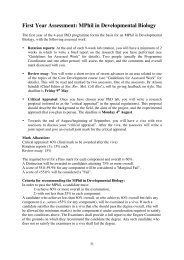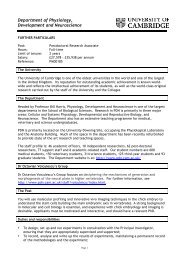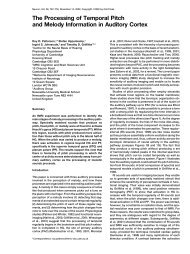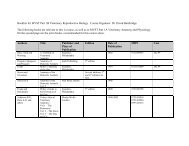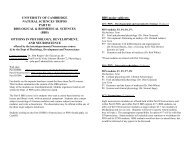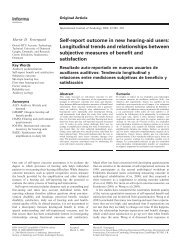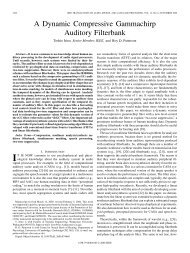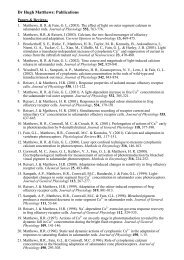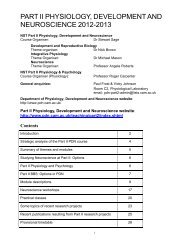FRIDAY MORNING, 20 MAY 2005 REGENCY E, 8:30 A.M. TO 12:00 ...
FRIDAY MORNING, 20 MAY 2005 REGENCY E, 8:30 A.M. TO 12:00 ...
FRIDAY MORNING, 20 MAY 2005 REGENCY E, 8:30 A.M. TO 12:00 ...
Create successful ePaper yourself
Turn your PDF publications into a flip-book with our unique Google optimized e-Paper software.
hearing were presented with voices that varied systematically in terms of<br />
their aspiration noise and spectral slope. The stimuli, five male and five<br />
female voices, were generated using the Klatt synthesizer and were modeled<br />
after naturally occurring voices. Listeners rated breathiness for each<br />
of these stimuli using a 7-point rating scale. Results show the relative<br />
contribution of spectral slope and aspiration noise to the perception of<br />
breathiness.<br />
5pSC32. Intensity variation in vowels across acoustic and auditory<br />
spectra. Ewa Jacewicz and Robert Allen Fox Dept. of Speech and<br />
Hearing Sci., The Ohio State Univ., Columbus, OH 43210,<br />
jacewicz.1@osu.edu<br />
Changes to vowel intensity are affected primarily by an increased<br />
physiological effort of the speaker. A second source of intensity variation<br />
comes from immediate consonant environment of the vowel as a result of<br />
coarticulation House & Fairbanks, J. Acoust. Soc. Am. 22, 105–113<br />
1953. Variation in intensity distribution across the vowel spectrum was<br />
measured for eight American English vowels in ten symmetrical CVC<br />
environments consonants included both stops and fricatives at four different<br />
locations at the vowels rms peak and at points corresponding to<br />
<strong>20</strong>%, 50%, and 80% of the vowels duration. Three types of spectral<br />
intensity distribution were examined: 1 the relative amplitudes of formants<br />
F1-F4; 2 the summed intensity in four contiguous frequency<br />
bands of 0–0.5, 0.5–1.0, 1.0–2.0 and 2.0–4.0 kHz Sluijter and Van Heuven,<br />
J. Acoust. Soc. Am. 1<strong>00</strong>, 2471–2485 1996; and 3 the intensity<br />
distribution following three stages of auditory processing using an auditory<br />
filter bank consisting of 33 filters, equal loudness pre-emphasis, and<br />
intensity-loudness compression. The nature and size of the effects of<br />
spectral intensity variation as a function of consonant environment in the<br />
acoustic spectrum formants and in auditory pre-processing of the acoustic<br />
spectrum will be compared. Work supported by NIDCD R03<br />
DC<strong>00</strong>5560-01.<br />
5pSC33. Voice onset time is shorter in high-frequency words. Mark<br />
VanDam and Robert Port Dept. of Linguist., Indiana Univ, Bloomington,<br />
IN 47405<br />
Frequency of occurrence is known to have many effects on speech<br />
production see J. Bybee, Phonology and Language Use Cambridge,<br />
<strong>20</strong>01 including vowel quality, overall duration, rate of deletion, assimilation,<br />
coarticulation, etc. The current work addresses voice-onset time<br />
VOT in words with differing lexical frequency estimates from published<br />
materials and addresses whether words in a list exhibit similar effects to<br />
words in sentential context. Four talkers produced <strong>20</strong> low frequency words<br />
and 10 high frequency words four times each in isolation and again in<br />
non-idiomatic, sentential context. VOT was measured in monosyllabic<br />
content words with initial /t/. Results show that frequent words e.g., talk,<br />
table have a mean VOT roughly 10 ms shorter than less frequent words<br />
e.g., talc, taint (p0.01). The effect was significantly stronger for<br />
words in a sentence e.g., He will talk to his supervisor than in a list.<br />
These findings are consistent with linguistic theories that propose detailed<br />
auditory representations for words and finely controlled productions, but<br />
are in conflict with traditional, abstract phonological representations.<br />
5pSC34. Tension asymmetries in a finite element model of the vocal<br />
folds. Greg S. Davidson Univ. of Chicago, Chicago, IL 60637 and<br />
Fariborz Alipour Univ. of Iowa, Iowa City, IA 52242<br />
Tension asymmetries in a finite element model of the vocal folds were<br />
examined as a function of lung pressure. The vocal fold model had an<br />
asymmetry in the tension ratio ranging from 1.1 to 2.0, corresponding to a<br />
10%–1<strong>00</strong>% increase in tension of the left fold compared to the right, and<br />
lung pressure was increased over the range 5–40 cm H 2 O. For tension<br />
ratios greater than 1.6, oscillation was not supported over most of this<br />
range. For tension ratios less than 1.6, the fundamental frequency was<br />
found to increase up to approximately 22 cm H 2 O. Mean vocal fold contact<br />
area showed a broad maximum over the range 8–13 cm H 2 O and<br />
decreased between 13 and 22–25 cm H 2 O. Open quotient decreased between<br />
7.5 and 13–15 cm H 2 O and increased afterwards to reach a maximum<br />
value between <strong>20</strong> and 23 cm H 2 O. For these three parameters, the<br />
behavior above the upper thresholds was tension ratio dependent. Mean<br />
glottal area linearly increased with lung pressure with differing slopes over<br />
different pressure ranges. Taken together, the four parameters provide evidence<br />
for different vibratory domains. Work supported by NIDCD grant<br />
No. DC03566.<br />
5pSC35. Not just any contour: Intonation marking semantic domain<br />
narrowing. Karsten A. Koch Univ. of British Columbia, Vancouver,<br />
BC, Canada<br />
Not just any statements Natalie won’t drink just ANY wine from<br />
France carry an intonational contour. Previous studies have characterized<br />
the contour as fall-rise D. Robert Ladd, The structure of intonational<br />
meaning 1980, but more intricate acoustic analysis that considers the<br />
semantics of the construction has not been performed. Preliminary data<br />
shows that for speakers of Canadian English, the contour contains a risefall<br />
and stress accent on any, followed by a rise on the sentence-final<br />
syllable. If the stressed rise-fall on any indicates a topic accent, then the<br />
meaning of the construction can be calculated semantically: the presence<br />
of the topic accent indicates a disputable topic in this case, Which wines<br />
will Natalie drink? following Daniel Buering, Linguistics and Philosophy<br />
<strong>20</strong>, 175–194 1997 for German. This operation narrows the domain<br />
of any wine from all wine from France to some smaller amount perhaps<br />
Natalie only drinks expensive cabernets. Furthermore, the same intonational<br />
contour occurs in other quantificational statements, like ALL gamblers<br />
aren’t addicted. Here, the disputable topic is: How many gamblers<br />
are addicted? Again, the intonation serves to narrow the domain to a<br />
subset of all the gamblers. Thus, documenting this intonational contour<br />
identifies a more general semantic process.<br />
5pSC36. The role of stress accent in the understanding of sentences in<br />
noise. Pierre Divenyi and Alex Brandmeyer Speech and Hearing Res.,<br />
VA Medical Ctr., 150 Muir Rd., Martinez, CA 94553<br />
When a target sentence is presented in noise, the stressed syllables<br />
therein will constitute epochs with a high likelihood of S/N increase. Since<br />
in spontaneous speech stressed syllables have significantly higher information<br />
content than unstressed syllables S. Greenberg et al., in Proc. 2d<br />
Intern. Conf. Human Lang. Technol. Res. <strong>20</strong>02, pp. 36–43, it follows<br />
that masking the stressed syllables will negatively impact the perception of<br />
neighboring unstressed syllables. This hypothesis was tested by varying<br />
the S/N of only the stressed syllables in sentences embedded in otherwise<br />
unmodulated speech-spectrum noise. Results suggest that, compared to<br />
conditions with absent or decreased-S/N stressed syllables, increasing the<br />
S/N during stressed syllables increases intelligibility of the unstressed syllable<br />
or syllables that follow. Since the unstressed syllables are rarely<br />
masked in the classic, energetic sense, the phenomenon reported constitutes<br />
an instance of informational masking. The masking can affect perception<br />
at the phonemic as well as on higher linguistic levels, depending<br />
on the information provided by sentence context.<br />
2623 J. Acoust. Soc. Am., Vol. 117, No. 4, Pt. 2, April <strong>20</strong>05 149th Meeting: Acoustical Society of America 2623<br />
5p FRI. PM



